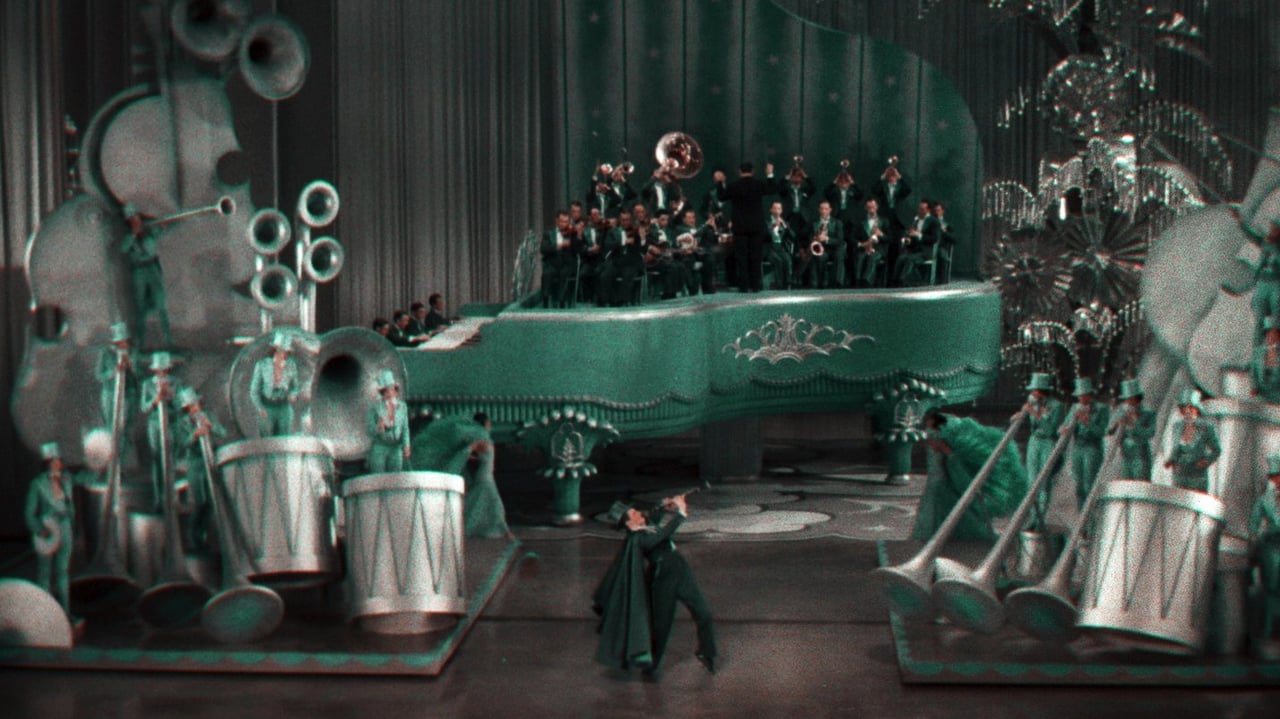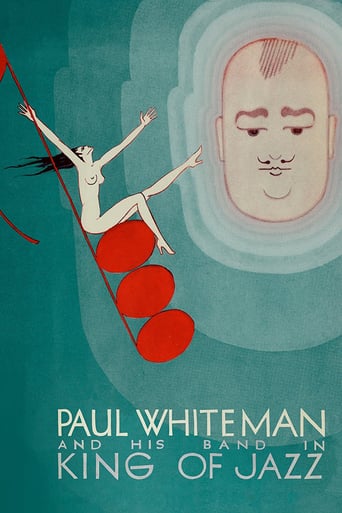



Sorry, this movie sucks
everything you have heard about this movie is true.
View Moreif their story seems completely bonkers, almost like a feverish work of fiction, you ain't heard nothing yet.
View MoreIt’s not bad or unwatchable but despite the amplitude of the spectacle, the end result is underwhelming.
View MoreNot only is this extravagant, $2 million Musical/Comedy production from 1930 a real sweet treat of vintage movie-making - But - As an added bonus - You'll actually get to see the very first filmed sequence of "moonwalking" (55 years before late pop-icon, Michael Jackson popularized it).Yes. Indeed. "The King of Jazz" is pure "Depression-Era" escapism that's all glitz and glamour from start to finish.I was certainly quite surprised to find out that upon this picture's initial release (with its added novelty of being filmed in 2-tone Technicolor) - It actually bombed, big-time, at the box-office.
View MoreUniversal spent over a year making this movie -- Paul Whiteman's band set forth for Hollywood on a chartered train called the "Old Gold Special" in January 1929 (Old Gold Cigarettes sponsored his CBS radio program) and arrived, ready to work, only to find that no one at Universal had bothered to come up with a script. Seven months later he headed himself and his band back to New York after telling the "suits" at Universal he wasn't coming back until there was a finished script and the film was ready to shoot. During the stand-down Whiteman lost the best musician he ever had, Bix Beiderbecke, to Bix's chronic alcoholism, and Universal lost the originally assigned director, Paul Fejos, when he had a nervous breakdown while shooting another film. By the time Whiteman returned, the Great Depression had hit, the Zeitgeist had changed and the American people weren't in the mood for lavish musicals anymore. So "King of Jazz" became a legendary box-office flop.It's a fate the movie didn't deserve: though there are a few scenes in which director John Murray Anderson falls back on the typical long-shots of chorus lines that make them look like ants on a wedding cake, for the most part his direction is vividly imaginative, fully the equal of what Busby Berkeley was doing on his first film, "Whoopee," another all-color musical being filmed at the same time. Anderson gives us numbers from overhead, from side angles, and uses the swooping camera movements of the so-called "'Broadway' Crane" (invented by cinematographer Hal Mohr and director Paul Fejos for Universal's 1929 film of the hit musical "Broadway") to deliver dazzling images and splendors to delight the eye and avoid the static quality of many of the early musicals. Anderson had come to Hollywood from his experience directing most of the Ziegfeld Follies on stage and running an acting school that trained Bette Davis and Lucille Ball, and for this film he was given virtually unprecedented authority. "King of Jazz" should have been his ticket to a major film career, but instead after its failure he retreated to the stage and only worked on two more films, the 1944 Esther Williams vehicle "Bathing Beauty" (for which he staged the incredible final number, often misattributed to Berkeley!) and Cecil B. DeMille's circus drama "The Greatest Show on Earth" (1953). It's a crime against culture that Anderson wasn't given the job of directing "The Great Ziegfeld" (1936), since he knew Ziegfeld's style (indeed, had helped create it) and he knew how to make a movie; an Anderson-directed "Great Ziegfeld" could have been a masterpiece instead of the ponderous bore (redeemed only by the acting of William Powell and Myrna Loy) MGM and hack director Robert Z. Leonard actually gave us."King of Jazz" was one of the handful of revues (a Broadway term for a musical with no plot) filmed in 1929 and 1930, including MGM's "Hollywood Revue of 1929," Warner Bros.' "The Show of Shows," Fox's "Fox Movietone Follies of 1929," and Paramount's "Paramount on Parade." (There was also a British version, "Elstree Calling," in which the framing scenes showing actor Gordon Harker tuning in variety performers on an early TV were directed by Alfred Hitchcock, who didn't think the assignment was important enough to put the film on his official résumé.) But "King of Jazz" is better than all of them, even though Universal's list of contract players was far less illustrious than those of their major-studio competitors (the biggest "names" in this movie who weren't part of Whiteman's organization were Laura LaPlante and John Boles). It helps that the comedy scenes between the big musical numbers are kept to a minimum, and are short, genuinely funny and surprisingly racy for a 1930 film. The only thing that badly dates this movie (and led me to rate it 9 instead of 10) are the unfunny and badly dated novelty songs, including "Oh, How I'd Love to Own a Fish Store," "Has Anybody Here Seen Nellie?" and Wilbur Hall's performance of "Stars and Stripes Forever" on a bicycle pump."King of Jazz" is a towering musical masterpiece, rivaled only by "Whoopee" at the top of the heap for pre-"42nd Street" musicals. (The Lubitsch and Mamoulian films for Maurice Chevalier and Jeanette MacDonald are in a separate category altogether.) The film is a tribute to the genius of its director, John Murray Anderson, though the one Academy Award it won was for its art director, Herman Rosse, probably the first individual ever to win an Oscar for an all-color film. "King of Jazz" is a music that will dazzle you with spectacular moment after spectacular moment, including the "Rhapsody in Blue" sequence that, along with the "New York Rhapsody" sequence in the 1931 film "Delicious," does more justice to George Gershwin's music than any sequence using it until the 1951 ballet in "An American in Paris."
View MoreFortunately, the history of jazz was little troubled by this farcical musical travesty. The one black person... (did you know that it was people of color who created Jazz, innovated and sustained it decade after decade only to be constantly supplanted by less talented and creative whites who popularized their music and made millions off it?)... who appears is a cute little girl sitting on the lap of Paul White-Man, the purported king of jazz in a brief segment. The only jazzy number in the film is 'Happy Shoes' with the entire remainder of the film devoted to middle of the road popular schmaltz music and pseudo-classical Gershwin. That said, the film, however distasteful, dated and unfunny, is in some ways an important historical predecessor of the Hollywood musicals to come.I had read that the production numbers were something to see, but by the end I no longer cared. Not so hot. Comedy, very poor. Female vocals, very poor. White-man and his vaudevillians, crap. Bing Crosby, as usual, quite good.
View MoreI oh so wanted to see this film desperately after seeing the awesome trailer for it. I mean, a two color musical, the first ever made for Warner Brothers! The King Of Jazz has no plot. Nada. Nil. Instead it's a whole pile of musical numbers and comedic skits. The whole thing is centered around a guy who was popular at the time, Paul Whiteman, and his orchestra. The one thing I really liked about this movie is the set design. THAT was truly gaga, but soon lame musical number after lame musical number envelops what good that does and makes this an AWFULLY uncomfortable sit through. Well, at least we got to see a very very young Bing Crosby. That's about all that makes this watchable.
View More